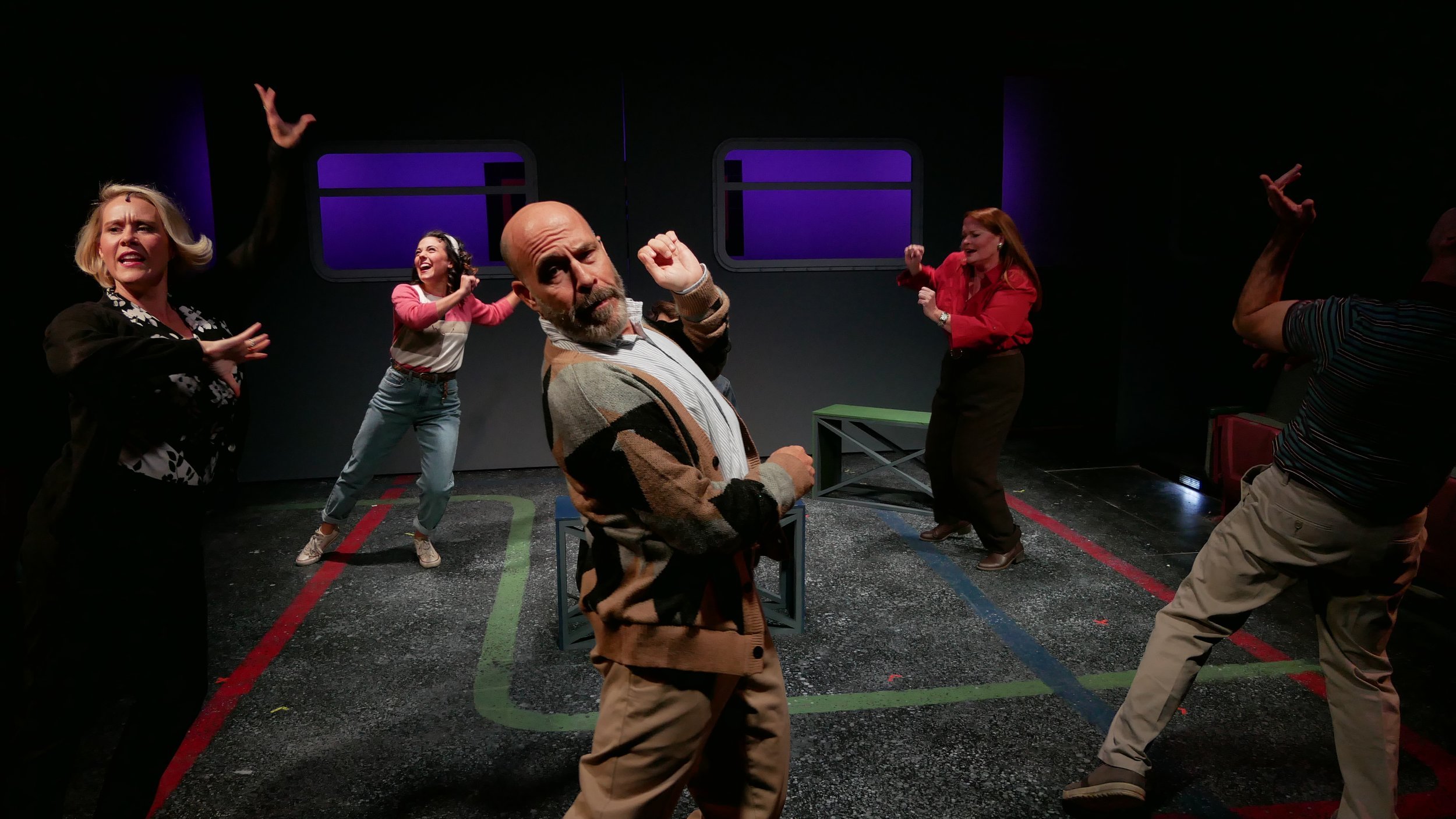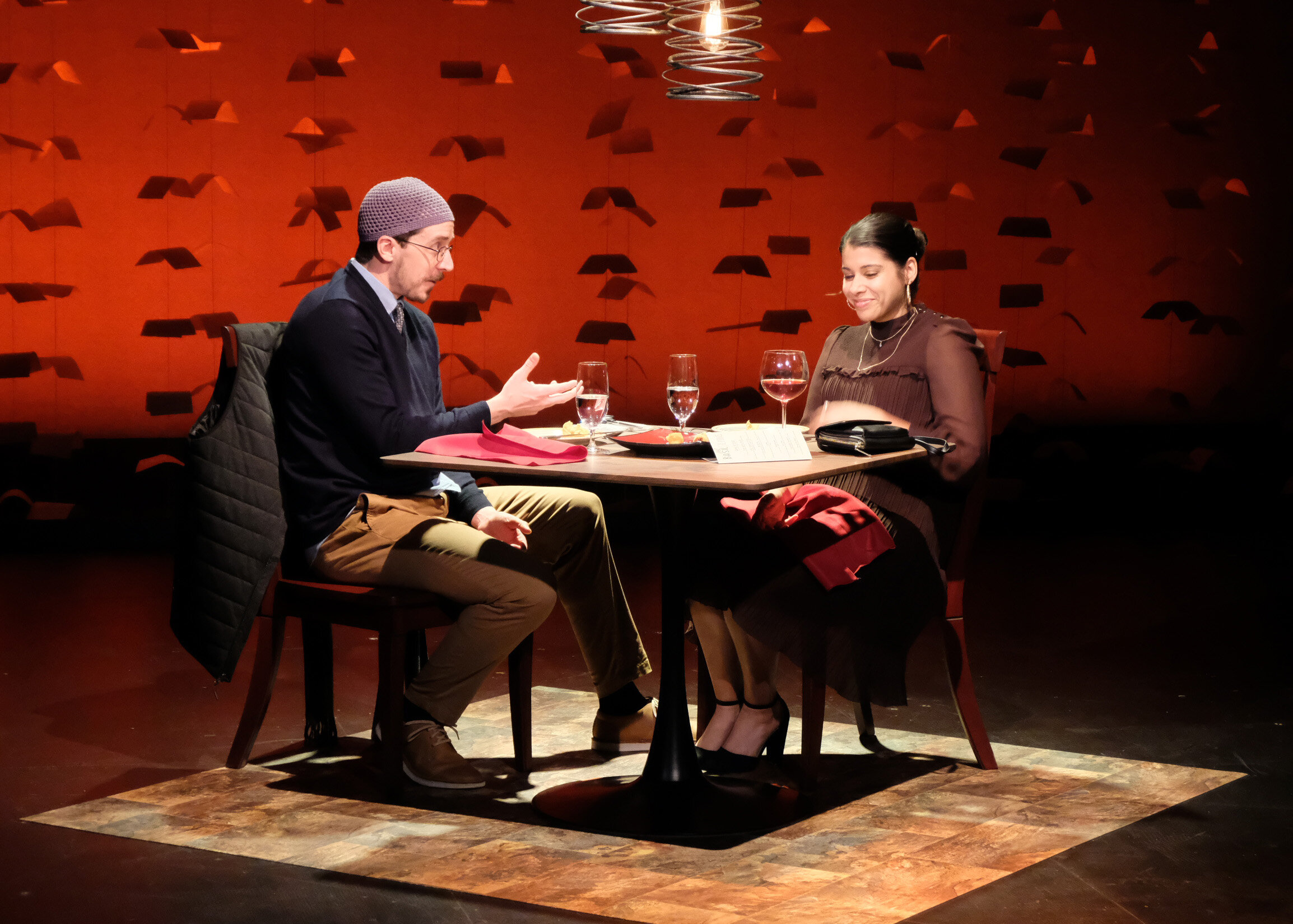Review of Kiss My Aztec, Hartford Stage
Hartford Stage ends its 2021-22 season with Kiss My Aztec, a raucous celebration of comedic theatricality. John Leguizamo has adapted his screenplay co-written with Stephen Chbosky into a spoof-fueled musical. The book is by Leguizamo and Tony Taccone, who directs the show; the music is by Benjamin Velez with lyrics by David Kamp, Velez and Leguizamo. Leguizamo, a Columbian-American comedian, film actor, and Tony-winning Broadway performer/playwright, is known for exploring his ethnicity in his plays, while also being familiar for his flamboyant characterizations in films (two of my favorite Leguizamo roles were directed by Baz Luhrmann, and Luhrmann’s work seems to have inspired some of the frenetic staging of Aztec). Thanks to the skills and stage brio of its fifteen-person cast, the show’s energy never flags and its aural and visual inventiveness makes Kiss My Aztec, even at two-and-a-half hours, feel freewheeling and fun.
The Spanish ensemble cast of Kiss My Aztec at Hartford Stage, directed by Tony Taccone (photo by T. Charles Erickson)
Aztec is Leguizamo’s effort to apply the irreverent vibe that made Broadway hits of The Book of Mormon (2011) and Spamalot (2004) to the colonization of the Americas by the Spanish and the resistance by the Aztecs. While it shares in the zaniness of those earlier shows, aided by the rap energies unleashed on Broadway by Hamilton (2015), Aztec suffers a bit, in comparison, from the lack of cohesion of its target. Whatever their degree of historical validity, topics like the Arthurian legends, the founding of the Mormon religion, and the struggles of the founding fathers in the U.S. lend a definite gravitas for a satirist to dismantle.
Lacking such a sturdy scaffold for his spoofs, Leguizamo draws on older vibes—I was reminded at times of musical-comedy epics of inspired silliness such as The Court Jester (1955), starring Danny Kaye. Which is to say that an easy target is costume drama in general, marked by the “thees” and “thous” and “eths” of mock-Shakespearean lingo. Aztec also features fast-paced verbal sparring and songs that move the plot along while also mocking the familiar tropes of expository songs. The music is bright with the brio that comes from throwing every relevant style into the mix, so that every number almost speaks a different idiom. The Latinx aesthetic of the show is palpable in its percussive music—Roberto Sinha, music director, and Wilson R. Torres, additional percussion arrangements—and amazingly vibrant costumes and set (Clint Ramos, both). As has been a hallmark of several successful Hartford Stage productions, it’s simply fun to watch the show happen.
Maria-Christina Olivera as Tolima in Kiss My Aztec, Hartford Stage (photo by T. Charles Erickson)
The story? We open with a look at how “White People on Boats” are always bad news for indigenous populations, then focus upon a group of Aztec caricatures who are intending to stave off an invasion by Spanish caricatures—including the Inquisition, and the imposition of all things Spanish, like tapas, by Rodrigo (played for all its worth by Matt Saldivar), viceroy in the New Land, who resides in the citadel with his oft-belittled son Fernando (Z Infante, a master of the slow burn). The witch-savant of the Aztecs, Tolima (Maria-Christina Oliveras, perfect for the part) gives a prophecy to El Jaguar Negro (Eddie Cooper, a sturdy leader) and his followers about a “great brown hope” that may rise up and expel the invaders under a blood red moon. To that end, Colombina (Krystina Alabado, very lively), a warrior who rebels against traditional female roles, and Pepe (Joel Perez, like a cross between Elliot Gould and Will Farrell), a sock-puppet-wielding clown (or “Punk-ass Geek-A”) who dotes on her, seek entrance to the citadel to assassinate Rodrigo.
Columbina (Krystina Alabado) confronts Rodrigo (Matt Saldivar) as Pepe (Joel Perez) looks on, and guards interfere in Kiss My Aztec at Hartford Stage (photo by T. Charles Erickson)
Their task will involve disguises, of course, and the introduction of a host of gags, from a phallic codpiece brandished by “the fixer” Pierre (Richard Ruiz Henry, priceless), to hypnotized-slap routines, to rap-throwdowns. And dances and sacrifices and skirmishes. Along the way there is also time for all kinds of romantic entanglements—whether its Cooper wildly inappropriate as a lovestruck Inquisitor dallying with Fernando in “Tango in the Closet,” or Spanish princess Pilar (Desireé Rodriguez, hilarious) refusing Sebastian (Z Infante), while pining for revelatory “dark meat”; likewise, Sebastian, tired of incestuous couplings for the sake of bloodlines, pines, complete with back-up singers, for a new girl from the new world; meanwhile Rodrigo confesses to Columbina his desire to be spooned. And don’t forget the big showstopping romantic longings of “Chained Melody” where the yearnings of Columbina and Pepe find a literal and lyrical expression.
Krystina Alabado as Columbina and Joel Perez as Pepe during their big romantic number in Kiss My Aztec at Hartford Stage (photo by T. Charles Erickson)
Kiss My Aztec not only has the makings of a Broadway show, it feels like it already is one. It may be true that it’s nothing new—except for its choice of which formerly marginalized population to appropriate and give a heroic-ironic treatment to—but the show is fully at home in our moment when the complex histories of immigrant and indigenous populations continue to strive for a hearing on various fronts. As a comedy, Aztec keeps its eye on ways to mock stereotypes and wring laughs out of unexpected mashups, while perhaps chuckling up its sleeve at the audience’s willingness to be so easily entertained, still.
Z Infante as Sebastian with KC Dela Cruz, Angelica Beliard, and Geena Quintos in Kiss my Aztec at Hartford Stage (photo by T. Charles Erickson)
One could say that the irreverence of plays like Aztec has attained a certain reverence on Broadway, their frames of reference capable of mocking any piety. Though there may come a point at which a new tonality will arrive, for now It’s still a treat to see cultural associations, historical footnotes, ideological appropriations and a host of progressive and regressive social attitudes given the bawdy, slangy 21st century-treatment, with song. The main target here is people with no sense of humor.
Columbina (Krystina Alabado) and Rodrigo (Matt Saldivar) in Kiss My Aztec at Hartford Stage (photo by T. Charles Erickson)
Kiss My Aztec
Book by John Leguizamo and Tony Taccone
Music by Benjamin Velez
Lyrics by David Kamp, Benjamin Velez and John Leguizamo
Based on a screenplay by John Leguizamo and Stephen Chbosky
Directed by Tony Taccone
Choreography by Mayte Natalio
Scenic and Costume Design: Clint Ramos; Lighting Design: Alexander V. Nichols; Sound Design: Jessica Paz & Beth Lake; Wig & Hair Design: Charles G. LaPointe; Puppet Design: James Ortiz; Music Supervision & Co-Incidental Music Arrangements: David Gardos; Dance, Vocal & Co-Incidental Music Arrangements: Benjamin Velez; Orchestrator: Simon Hale; Music Director: Roberto Sinha; Additional Percussion Arrangements: Wilson R Torres; Production Stage Manager: Jeffrey Rodriguez; Stage Manager: Amanda Michaels; Assistant Stage Manager: Hannah Woodward
Orchestra: Roberto Sinha, conductor/keyboard; David Kidwell, keyboard; Oscar Bautista, guitars; Amanda Ruzza, bass/synthesizer; Rosa Avila, drums; Wilson Torres, percussion; John Mastroianni, woodwinds; Don Clough, trumpet/flugelhorn; Scott Cranston, trombone
Cast: Krystina Alabado, Angelica Beliard, Chad Carstarphen, Nicholas Caycedo, Eddie Cooper, KC Dela Cruz, Richard Ruiz Henry, Z Infante, Jesús E. Martinez, Maria-Christina Oliveras, Joel Perez, Geena Quintos, Desireé Rodriguez, Matt Saldivar, Brittany Nichole Williams
Hartford Stage
June 1-26, 2022






















































































